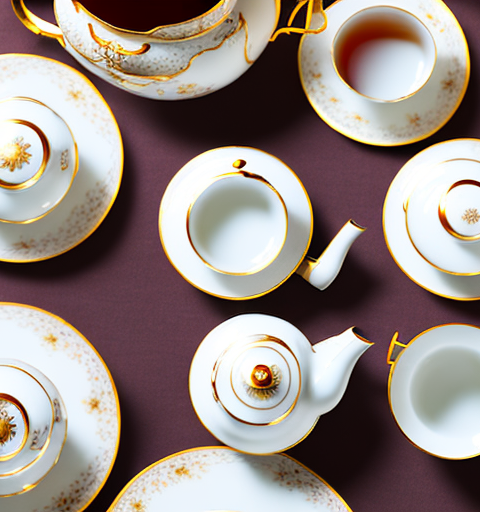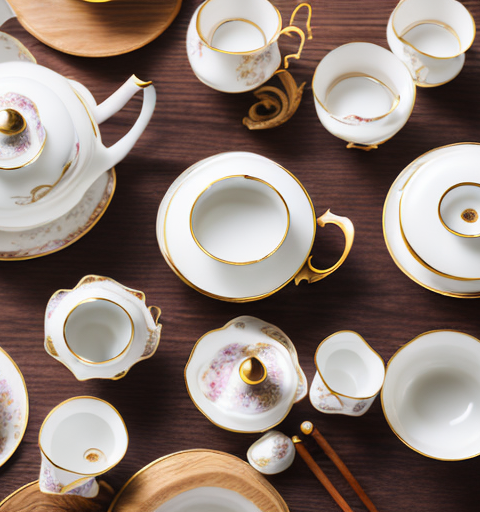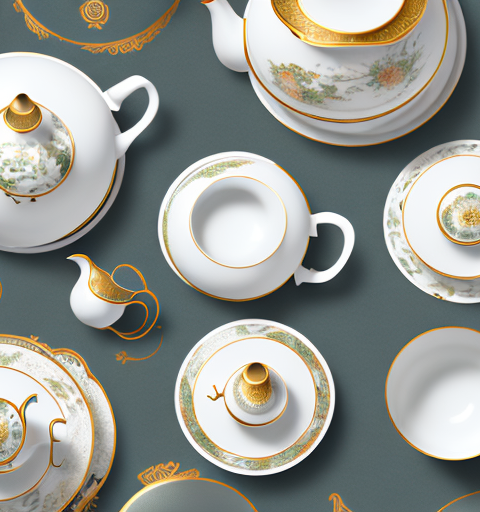Understanding the Safety of Ceramic Teapots in the Microwave
Ceramic teapots have been a staple in many households, cherished for their beautiful designs and ability to keep tea warm for longer periods of time. However, when it comes to using these teapots in the microwave, there is a common question that arises – are ceramic teapots microwave-safe? In this article, we will delve into the intricacies of ceramic teapots and explore whether they can be safely used in the microwave.
One of the main concerns when using ceramic teapots in the microwave is the potential for them to crack or shatter due to the rapid heating. Ceramic is a porous material, and when exposed to high temperatures, it can expand and contract, leading to stress on the teapot’s structure. This stress can cause the teapot to break, posing a safety risk.
A Comprehensive Guide to Using Ceramic Teapots in the Microwave
Many ceramic teapot enthusiasts wonder if they can pop their teapot into the microwave to quickly warm up their tea. The answer to this question is not a simple yes or no. Ceramic teapots, while generally safe to use in the microwave, require some precautions to ensure they are not damaged or pose any harm. Let’s dive deeper into the subject and understand the steps you can take to safely use your ceramic teapot in the microwave.
Firstly, it is important to check if your ceramic teapot is microwave-safe. Look for any labels or markings on the teapot that indicate it is safe for use in the microwave. If there are no such indications, it is best to avoid using the teapot in the microwave to prevent any potential damage.
Secondly, before placing your ceramic teapot in the microwave, make sure to remove any metal components such as the lid or infuser. Metal can cause sparks or damage to the microwave, so it is crucial to remove them before heating your teapot.
The Pros and Cons of Microwaving Ceramic Teapots
Microwaving ceramic teapots offers several advantages and disadvantages that every tea lover should consider. On the plus side, microwaving ceramic teapots allows for quick and convenient tea preparation. Additionally, the microwave’s even heat distribution helps maintain the intended flavors and aromas of the tea. However, there are also some downsides to be aware of, such as potential damage to the teapot if it is not microwave-safe or if it experiences sudden temperature changes. We will explore these pros and cons in detail to help you make an informed decision.
One of the main advantages of microwaving ceramic teapots is the time-saving aspect. Unlike traditional methods of heating water for tea, such as using a stovetop or kettle, microwaving allows for a much quicker preparation process. This can be especially beneficial for those who are always on the go or have limited time to spare.
Exploring the Impact of Microwaving on Ceramic Teapots
The process of microwaving can have varying effects on different materials, and ceramics are no exception. Understanding the impact of microwaving on ceramic teapots is crucial to determine whether it is safe and appropriate. We will delve into the science behind this process, exploring how ceramics interact with microwaves and discussing the potential risks and consequences of improper use.
One of the key factors that determine the impact of microwaving on ceramic teapots is the composition of the ceramic material. Different types of ceramics may react differently to microwaves, leading to varying outcomes. For example, some ceramic teapots may be specifically designed to withstand the heat generated by microwaves, while others may be more susceptible to cracking or breaking under such conditions.
How to Determine if Your Ceramic Teapot is Microwave-Safe
Ensuring the microwave safety of your ceramic teapot is of utmost importance to avoid any mishaps or damage. There are a few methods you can employ to determine if your ceramic teapot is microwave-safe or not. We will guide you through these techniques, providing you with the knowledge to confidently use your teapot in the microwave.
One method to determine if your ceramic teapot is microwave-safe is to look for a label or stamp on the bottom of the teapot. Many manufacturers will indicate if their ceramic products are safe for use in the microwave. Look for phrases such as “microwave-safe” or “microwave-friendly.” If you find this label, you can be confident that your teapot can be safely used in the microwave.
Another way to test the microwave safety of your ceramic teapot is to perform a simple water test. Fill your teapot with water and place it in the microwave. Heat the water for a minute or two, then carefully remove the teapot from the microwave. If the teapot is cool to the touch or only slightly warm, it is likely microwave-safe. However, if the teapot is hot or emits a burning smell, it is not safe for use in the microwave.
Tips for Safely Microwaving Ceramic Teapots
Once you have confirmed that your ceramic teapot is indeed microwave-safe, there are still some important tips to keep in mind to ensure safe and effective microwaving. From selecting the appropriate power level to avoiding sudden temperature fluctuations, we will share valuable insights to help you make the most out of your ceramic teapot in the microwave.
One additional tip to consider when microwaving a ceramic teapot is to always use a microwave-safe cover or lid. This will help to prevent any splattering or mess inside the microwave, as well as keep the heat and steam contained within the teapot. Additionally, using a cover can help to retain the heat and ensure that your tea stays hot for longer. Make sure to choose a cover that is specifically designed for microwave use and fits securely on your teapot.
Common Misconceptions about Microwaving Ceramic Teapots Debunked
Like with any topic, there are often misconceptions surrounding the microwaving of ceramic teapots. We will debunk some of the most common myths and clarify the facts, providing you with accurate information to make confident choices when using your ceramic teapot in the microwave.
One common misconception is that microwaving a ceramic teapot will cause it to crack or shatter. However, many ceramic teapots are microwave-safe and designed to withstand the heat generated by microwaves. It is important to check the manufacturer’s instructions or look for a microwave-safe label on the teapot before microwaving it.
The Science Behind Microwaving Ceramic Teapots
If you have ever wondered about the scientific principles that govern the interaction between ceramics and microwaves, this section is for you. We will delve into the intricate details of how microwaves work, how they heat ceramics, and what impact it has on your beloved teapot. Understanding these scientific principles will enable you to approach the subject with insight and appreciation.
One of the key scientific principles behind microwaving ceramic teapots is the phenomenon of dielectric heating. Dielectric heating occurs when a material, such as ceramic, is exposed to an alternating electric field, as generated by the microwaves. The alternating electric field causes the charged particles within the ceramic to rapidly change direction, resulting in friction and the generation of heat.
Unveiling the Truth: Can All Ceramic Teapots Be Used in the Microwave?
While ceramic teapots are generally suitable for microwave use, it is essential to note that not all ceramic teapots are created equal. Certain types of ceramics may not withstand the rigors of microwave heating, posing a risk of shattering or damage. In this section, we will discuss the different types of ceramics commonly used in teapots, their microwave-safety, and how to identify whether your teapot falls into the microwave-safe category.
One common type of ceramic used in teapots is earthenware. Earthenware is a porous material that is not typically microwave-safe. When exposed to high heat, the moisture trapped within the ceramic can expand rapidly, causing the teapot to crack or break. Therefore, it is important to check the manufacturer’s instructions or labeling to determine if your earthenware teapot is safe for microwave use.
On the other hand, stoneware and porcelain are often considered microwave-safe ceramics. These materials are denser and less porous than earthenware, making them more resistant to thermal shock. However, it is still advisable to exercise caution and follow the manufacturer’s guidelines, as some stoneware or porcelain teapots may have additional decorative elements or glazes that could be damaged by microwave heating.
Microwave-Safe or Not? The Ultimate Guide to Choosing Ceramic Teapots
When purchasing a new ceramic teapot, it is crucial to consider its suitability for microwave use. The market offers a wide range of ceramic teapots, each with different properties and characteristics. In this comprehensive guide, we will provide you with essential factors to consider, enabling you to choose a ceramic teapot that is both visually appealing and microwave-safe.
One important factor to consider when determining if a ceramic teapot is microwave-safe is the glaze used on the teapot’s surface. Some glazes may contain metallic elements that can cause the teapot to heat unevenly or even spark in the microwave. It is recommended to look for teapots with lead-free and food-safe glazes, as these are more likely to be microwave-safe.
Precautions to Take When Microwaving Your Ceramic Teapot
Even when armed with the knowledge of whether your ceramic teapot is microwave-safe, it is important to take precautions to ensure optimal safety and performance. We will outline some key steps and suggestions to follow when microwaving your ceramic teapot, allowing you to enjoy a worry-free tea experience.
Firstly, before microwaving your ceramic teapot, make sure to remove any metal components such as the lid or infuser. Metal can cause sparks and damage the microwave, as well as potentially pose a safety hazard. It is best to use a microwave-safe alternative, such as a microwave-safe plate or microwave-safe plastic wrap, to cover the teapot while heating.
Secondly, always use oven mitts or heat-resistant gloves when handling the ceramic teapot after microwaving. The teapot and its contents can become extremely hot during the heating process, and it is important to protect yourself from burns. Allow the teapot to cool for a few minutes before removing it from the microwave, and use caution when pouring the hot liquid.
Exploring Alternative Methods for Heating Ceramic Teapots
If microwaving is not the preferred method for heating your ceramic teapot or if your teapot is not microwave-safe, there are alternative ways to heat your tea without compromising its flavor or risking damage to your teapot. We will explore these alternative heating methods, equipping you with various options to suit your personal preferences and teapot characteristics.
One alternative method for heating your ceramic teapot is to use a stovetop. Simply fill a pot with water and place your teapot inside. Heat the water on the stovetop until it reaches the desired temperature. This method allows for precise control over the heating process and is suitable for teapots of all sizes.
How to Test the Microwave-Safety of Your Ceramic Teapot
For those who already own a ceramic teapot but are unsure of its microwave-safety, there are simple tests you can conduct to determine its suitability. We will guide you through these tests step by step, providing you with a straightforward method to assess whether your teapot can safely withstand the microwave.
One of the first tests you can perform is the water test. Fill your ceramic teapot with water and place it in the microwave. Heat the water for one minute on high power. Carefully remove the teapot from the microwave and feel the exterior. If the teapot is cool to the touch, it is likely microwave-safe. However, if the teapot is hot or warm, it may not be suitable for use in the microwave.
Another test you can try is the dishware compatibility test. Place a microwave-safe dish, such as a glass plate, in the microwave along with your ceramic teapot. Heat the teapot and the dish for one minute on high power. Afterward, check the dish for any signs of damage, such as cracks or discoloration. If the dish remains intact and undamaged, it is a good indication that your ceramic teapot is microwave-safe.
Understanding the Impact of High Temperatures on Ceramic Teapots
Exposure to high temperatures can have detrimental effects on ceramics if they are not designed to withstand them. In this section, we will discuss the implications of subjecting your ceramic teapot to high temperatures, including the potential for cracking, warping, or damage. Understanding these impacts will help you make informed decisions when heating your ceramic teapot.
By the end of this comprehensive article, you will have gained a deep understanding of the safety considerations, pros and cons, testing methods, and alternative options associated with microwaving ceramic teapots. Armed with this knowledge, you can confidently decide whether to use your ceramic teapot in the microwave or explore alternative means of heating your tea. Remember, the key is to strike a balance between convenience and protecting the integrity of your beloved ceramic teapot.
Understanding the Impact of High Temperatures on Ceramic Teapots
Exposure to high temperatures can have detrimental effects on ceramics if they are not designed to withstand them. In this section, we will discuss the implications of subjecting your ceramic teapot to high temperatures, including the potential for cracking, warping, or damage. Understanding these impacts will help you make informed decisions when heating your ceramic teapot.
One of the main reasons why ceramic teapots are susceptible to damage from high temperatures is their composition. Ceramics are made from clay, which is a porous material. When exposed to extreme heat, the moisture trapped within the clay can expand rapidly, leading to cracks or even the complete destruction of the teapot. Additionally, the glaze used to coat the teapot may not be able to withstand high temperatures, resulting in discoloration or flaking.
It is important to note that not all ceramic teapots are created equal when it comes to heat resistance. Some teapots are specifically designed to withstand high temperatures, while others are more delicate and should only be used with lower heat sources. Before subjecting your ceramic teapot to high temperatures, it is crucial to check the manufacturer’s guidelines or consult with a knowledgeable expert to ensure its suitability.






